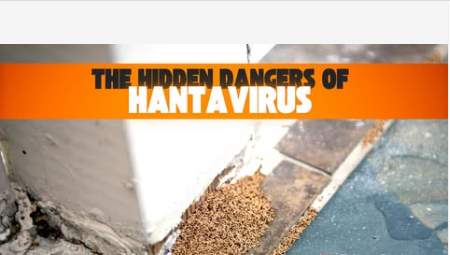People frequently picture airborne diseases that spread quickly among people when they think of deadly viruses. Hantavirus disease, on the other hand, is distinct in that it typically does not spread from person to person. Rather, it lurks in plain sight, being carried by rodents, and infects humans by exposing them to tainted urine, saliva, and droppings.
Because of its high death rate, hantavirus is a serious threat even though it is relatively uncommon. Hantavirus has no known cure, in contrast to seasonal flu, which has a wide range of available treatments. Thus, the best ways to protect yourself are through early detection, awareness, and prevention.
Hantavirus Disease: What Is It? Comprehending This Uncommon Yet Deadly Virus
The term “hantavirus disease” describes a collection of illnesses brought on by various hantavirus strains that are spread from rodents to people. There are two primary forms of the disease, each with unique symptoms and risk factors:
1️⃣ Hantavirus Pulmonary Syndrome (HPS) – Found in the Americas, this form affects the lungs and can be fatal within days.
2️⃣ Hemorrhagic Fever with Renal Syndrome (HFRS) – Common in Europe and Asia, it leads to kidney failure and internal bleeding.
| Disease Type | Region | Symptoms | Fatality Rate |
|---|---|---|---|
| Hantavirus Pulmonary Syndrome (HPS) | North & South America | Fever, lung infection, shortness of breath | 35–50% |
| Hemorrhagic Fever with Renal Syndrome (HFRS) | Europe, Asia | Kidney failure, high fever, internal bleeding | 1–15% |
| Nephropathia Epidemica (NE) | Europe | Milder form of HFRS, flu-like symptoms | <0.5% |
📌 Key Fact: There is no specific cure or antiviral treatment for Hantavirus disease, making prevention the best defense.
🔗 Learn More from the CDC: Centers for Disease Control and Prevention
How Do People Get Hantavirus? The Hidden Risk of Rodent Exposure
Unlike many contagious diseases, Hantavirus is not spread through direct human contact (except for a rare strain in South America). Instead, it thrives in rodent populations, infecting humans through contaminated environments.
🔴 How Infection Happens:
✔ Breathing in Virus Particles – The most common way people get infected. Sweeping or disturbing rodent droppings can send virus-laden particles into the air.
✔ Touching Contaminated Surfaces – If you come into contact with infected urine, droppings, or nesting material and then touch your face, you may become infected.
✔ Rodent Bites – Though rare, direct bites from infected rodents can introduce the virus into the bloodstream.
👷 Who Is at the Highest Risk?
✔ Farmers, forestry workers, and people working in rodent-heavy environments.
✔ Campers, hikers, and individuals spending time in the wilderness.
✔ Homeowners and renters who clean rodent-infested spaces, such as attics, sheds, or barns.
What Are the Symptoms of Hantavirus? Early Warning Signs
Hantavirus infection begins with flu-like symptoms, which makes it difficult to diagnose early on. However, as the disease progresses, it becomes life-threatening.
⚠ Early Symptoms (1–2 weeks after exposure):
✔ High fever (above 101°F)
✔ Muscle aches and extreme fatigue
✔ Severe headaches
✔ Nausea and vomiting
⚠ Severe Symptoms:
✔ Hantavirus Pulmonary Syndrome (HPS): Difficulty breathing, fluid-filled lungs, low oxygen levels.
✔ Hemorrhagic Fever with Renal Syndrome (HFRS): Internal bleeding, kidney failure, dangerously low blood pressure.
🚨 Seek Emergency Medical Help If You Experience:
✔ Sudden shortness of breath
✔ Coughing up blood
✔ Chest pain or difficulty urinating
✔ Confusion or loss of consciousness
Without immediate hospitalization, Hantavirus can rapidly worsen, making early recognition critical for survival.
How Is Hantavirus Treated? Medical Strategies and Challenges
Currently, there is no specific antiviral drug that cures Hantavirus disease. Treatment focuses on managing symptoms and preventing complications.
🔹 For Hantavirus Pulmonary Syndrome (HPS):
✔ Oxygen therapy and mechanical ventilation to support breathing.
✔ Intubation may be needed for severe respiratory distress.
🔹 For Hemorrhagic Fever with Renal Syndrome (HFRS):
✔ IV fluids and electrolyte management to prevent dehydration.
✔ Dialysis for patients experiencing kidney failure.
🔹 Research and Experimental Treatments:
✔ Ribavirin, an antiviral drug, has been tested in some severe cases but is not widely used.
✔ Vaccine research is ongoing, but no approved vaccine currently exists.
How to Prevent Hantavirus Disease: Simple Yet Effective Safety Measures
Because there is no vaccine or cure, the best way to stay safe is through prevention. By following proper hygiene and rodent control measures, you can greatly reduce your risk of exposure.
🏡 At Home:
✔ Seal any cracks or openings where rodents might enter.
✔ Store food in sealed containers and dispose of garbage regularly.
✔ Avoid sweeping rodent droppings—instead, spray with disinfectant and carefully wipe with disposable towels.
🎒 For Campers and Hikers:
✔ Keep food properly stored and away from sleeping areas.
✔ Never sleep directly on the ground in areas where rodents may burrow.
✔ Use protective gloves when handling firewood or cleaning outdoor spaces.
👷 For Workers in High-Risk Environments:
✔ Wear protective masks in rodent-infested areas.
✔ Disinfect tools and surfaces regularly.
✔ Avoid handling wild rodents in research or laboratory settings.
📌 Important Reminder: Hantavirus can remain active on surfaces for up to two weeks—always disinfect thoroughly before re-entering rodent-infested spaces.
Why Awareness About Hantavirus Disease Matters
While Hantavirus disease is not as well-known as other viral infections, its high fatality rate and lack of treatment options make it a serious concern. By understanding how the virus spreads and taking simple yet effective prevention measures, individuals can protect themselves and their families.
📌 Key Takeaways:
✔ Hantavirus is spread through rodent droppings, urine, and saliva—not person-to-person.
✔ Early symptoms mimic the flu but can rapidly progress to life-threatening complications.
✔ There is no cure, making prevention the most effective defense.
✔ Proper rodent control, hygiene, and awareness can significantly lower the risk of infection.
By staying informed and taking precautions, you can minimize the risk of contracting this dangerous disease.
🔗 For more information, visit the CDC’s official page on Hantavirus: Hantavirus Information


